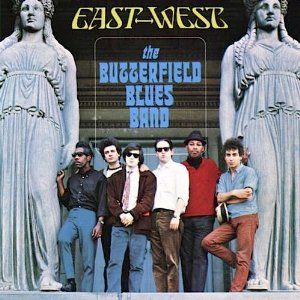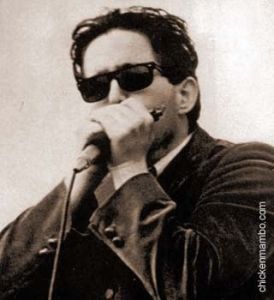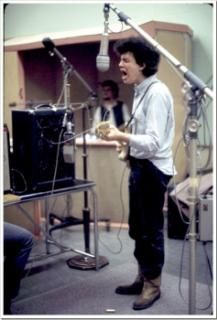Lost Album Classics Volume III
 Album Title: East-West
Album Title: East-West
Artist: The Paul Butterfield Blues Band
Year of Release: 1966
Few white blues players have been able to transcend the traditional notion that blues is a music that is based on the shared experiences of African Americans. Authenticity equals credibility in the minds of most blues enthusiasts. It's a powerful argument; and few white performers have been able perform the blues without inviting comparisons to the original African American blues masters.
 Paul Butterfield
Paul Butterfield
Paul Butterfield never invited comparisons because he demanded that listeners accept him on his own terms as an artist, and even the old blues masters could not deny Butterfield's prodigious talents and his inspired performances. The Butterfield Blues Band was one of those rare performing ensembles that could leave audiences dumb-founded by the sheer force of charismatic stage performances. Butterfield was "authentic" because he refused to accept the stereotypes of white blues performers and his passion and magnetism changed the rules about who can, and cannot play, authentic blues.
Butterfield's harmonica playing was more refined and sophisticated than Sonny Boy Williamson or Little Walter. Buttterfield also had the advantage of amplifying his harmonica with a modern high performance studio microphone which allowed him to modulate the tone and volume of his harmonica.
When Butterfield played his turbo-charged version of "Walking Blues", it was pointless to debate the merits the Robert Johnson original, because the Butterfield treatment of "Walking Blues" is so electrifying, that the racial identity of the singer is a moot point.
It was almost serendipity that Michael Bloomfield ended up in the same band with Butterfield. There really wasn't room enough in the same band two performers with such monumental talents and unshakable opinions of music.
Bloomfield was a Columbia Record Company studio musician and a budding 21 year old guitar prodigy, when the brilliant producer, Jac Holtzman suggested that Bloomfield be added to the band to fill out the band's recording sound. In addition to the Butterfield Blues Band; Holtzman discovered, signed and produced such ground breaking artists as Tim Buckley, the Doors, Love, the Stooges, and MC5 to his Eleckra record label. Elecktra was the leading independently owned rock label of the Sixties.
Butterfield reluctantly added Bloomfield to the band and thus began a turbulent partnership in which the two musical wunderkinds fought like a pair of panthers in a bamboo cage. It was the musical rivalry between Butterfield and Bloomfield that generated the high octane stage performances of the Butterfield Blues Band. I've heard demos of the Butterfield Blues Band before Michael Bloomfield was added as guitarist and the improvement in the band's sound with the addition of Bloomfield is striking contrast to the demos.
 Michael Bloomfield
Michael Bloomfield
Bloomfield's musical signature was his tension and release guitar technique: He began with slow knotty phrases building into an almost unbearable tension which he released in a blazing cascade of notes. Bloomfield was a master of feedback sustain, learning those techniques from blues guitarist Albert King. Bloomfield's playing was such a highly stylized pastiche of jazz, blues, and world music that only a musical scholar could discern the diverse sources his guitar techniques.
In a musical age that produced guitar gods like Jeff Beck, Eric Clapton, Jimmy Page, Jerry Garcia, Carlos Santana, Duane Allman and Johnny Winter, Bloomfield was arguably those most technically proficient and emotionally explosive guitar player of his generation. Bloomfield's career was cut short by his prodigious consumption of heroin. By the end of the Sixties, Bloomfield refused to travel outside of San Francisco (where he procured his drugs) to record or tour. Over the next 10 years he recorded a few uninspired solo albums and was written off by the music industry and his fans as a hopeless junkie. Bloomfield was found dead of a drug overdose in his car on February 15, 1981.
Shortly after joining the Butterfield Band in 1965, Bloomfield began writing experimental compositions using Eastern musical modalities that were radically different from the familiar major-minor tonal system of Western music.
Late in 1965, Bloomfield presented a piece to the band that he had been working on for well over a year which he titled
East-West. There was no precedent for the composition. It was a jazz piece, in the sense that Bloomfield's constructed themes were jump-off points for long improvisational solos by members of the Butterfield Blues Band. What was unprecedented about
East-West was the dizzying array of musical styles encompassing blues, jazz, samba and other exotic musical themes. The center piece of tension was a blues themed jam that segued into an eastern influenced Indian raga jam where Bloomfield manipulated the tone his Les Paul guitar and used feedback sustain to imitate the sound of a sitar.
East-West broke open a whole new musical space that was previously occupied by nothingness .
East-West was arguably the first recorded psychedelic jam and influenced countless rock musicians to test their own improvisational skills. A year later, in 1967 dozens of bands like Cream, the Jimi Hendrix Experience and the Grateful Dead were performing their own epic improvisational jams inspired by the psychedelic sounds of
East-West.
46 years later
East-West has endured as a musical milestone in pop music. After 1966, Butterfield and Bloomfield parted ways but both stuck pretty close to their blues roots. Each musician recorded a few songs that fused blues with psychedelic music... but none of those songs had the universal impact of
East-West.